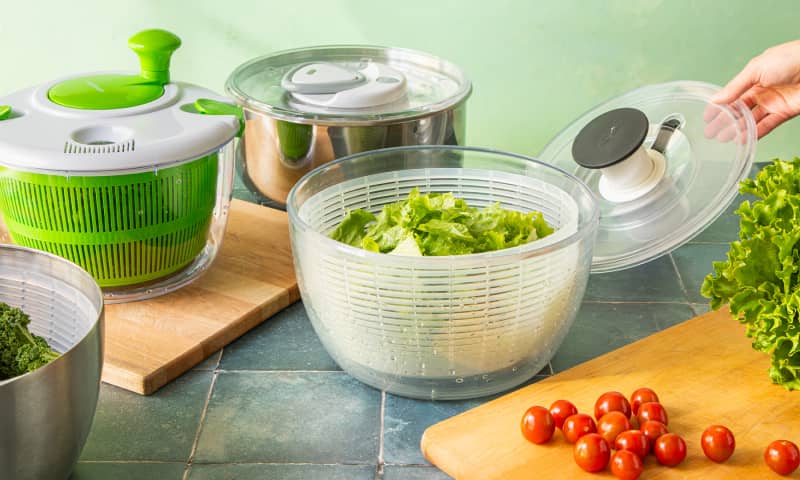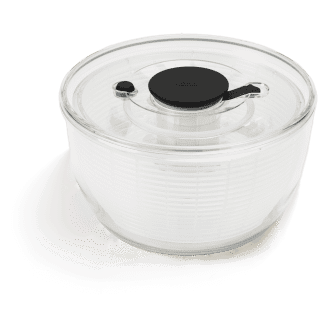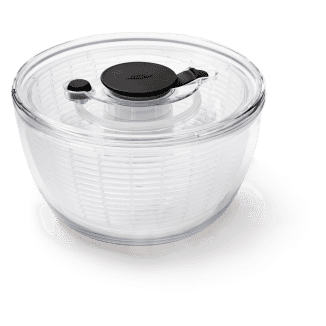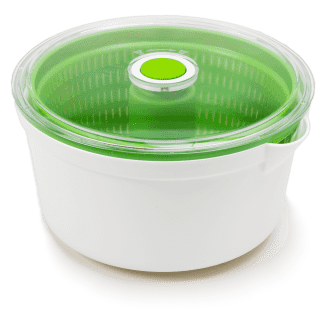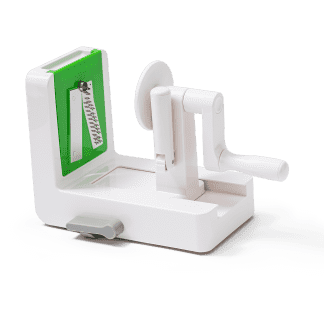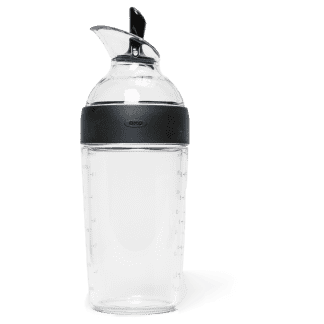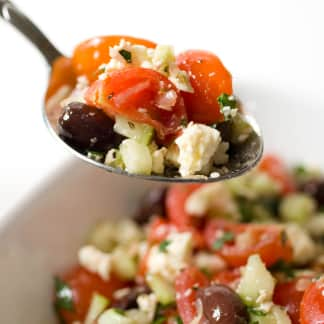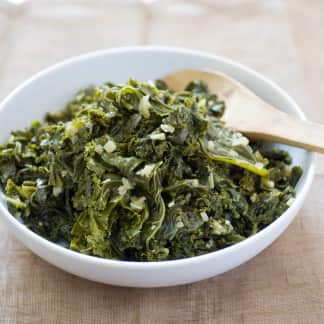The best salad spinners make short work of cleaning and drying greens and other vegetables. The OXO Good Grips Salad Spinner is our favorite. It’s spacious yet easy to store, and it’s straightforward to operate and clean. It dries greens more effectively than any other model we tested. We also like its smaller counterpart, the OXO Good Grips Little Salad and Herb Spinner, which works just as well but holds half as much—ideal if you’re only prepping herbs or greens for one or two people.

If you’re trying to eat plenty of greens, there’s no better tool than a salad spinner for cleaning and drying them. A salad spinner can dry larger bunches of greens faster and more thoroughly than you would ever be able to by hand but needs to be well-designed. It should be roomy enough to let you prep large quantities in the fewest possible batches. It must remove water thoroughly so that salad dressings can cling and sautés won’t splatter. Working the spinner should be reasonably easy and comfortable. And cleanup should be straightforward, with simple parts that don’t trap dishwater.
All the models in our lineup operate similarly: A perforated plastic basket sits inside a larger, lidded bowl. You use a mechanism—such as a crank, plunger, lever, or pull cord—to spin the basket, creating centrifugal force to expel liquid, which collects in the outer bowl and ideally leaves the basket contents dry. Pressing a brake button on top of each spinner stops the revolutions on demand.
What Size Salad Spinner Should You Get?
We think that a full-size salad spinner with a capacity of about 4 to 5.5 quarts is best for most households, allowing you to clean large and small volumes of greens easily. But if you only ever need to clean smaller batches of greens or herbs, or have limited storage space, a more compact option that holds about half that volume, or about 2.5 quarts, will suit you fine; we recommend the OXO Good Grips Little Salad and Herb Spinner.
What to Look For
- Thorough Drying: To evaluate how well the salad spinners removed water, we added a measured amount of identical greens and water to each spinner, spun it, and weighed the results. The best spinners dried greens thoroughly and quickly, removing all the water we added in our tests within 30 seconds of spinning. Many factors contributed to this efficiency, including stability, well-designed spinning mechanisms, and water collection space.
- No-Slip Bases: Our favorite models had patches of soft, grippy silicone at the bases of their bowls, which kept the spinners stable on the counter without us needing to clutch them with both hands.

- Plunger-Style Mechanisms: We preferred models with plunger-style spinning mechanisms. These consisted of a central plunger or pump in the lid that we pushed down, which transferred force to a system of gears in the lids that in turn caused the baskets to spin. We found these easiest to use: all we had to do was press down on the large pump buttons, which we could accomplish with one hand.
- Large Capacity: For full-size salad spinners, we preferred models that held at least 4 quarts, which let us load in plenty of greens and handle them confidently and required fewer batches to wash and dry large masses of greens. A few models’ spinning mechanisms—housed in their lids—were slightly bulky and jutted downward into the baskets by a few inches. But this protrusion wasn’t enough to severely limit their capacity and they still performed well.
- Simple, Well-Executed Design: Our preferred spinners had fewer parts and were straightforward to assemble and simple to take apart for cleaning and drying. Their lids and baskets locked together neatly and securely, which allowed us to spin with confidence, knowing the whole assemblage wouldn’t fall apart if we spun too fast.
- Ample Water Collection Space: We preferred spinners that suspended their baskets well above any runoff water that collected in the bowl; the more water that the bowl could collect without getting the greens wet again, the better. Our favorites could hold 1.75 cups of water before baskets’ contents began to get wet.
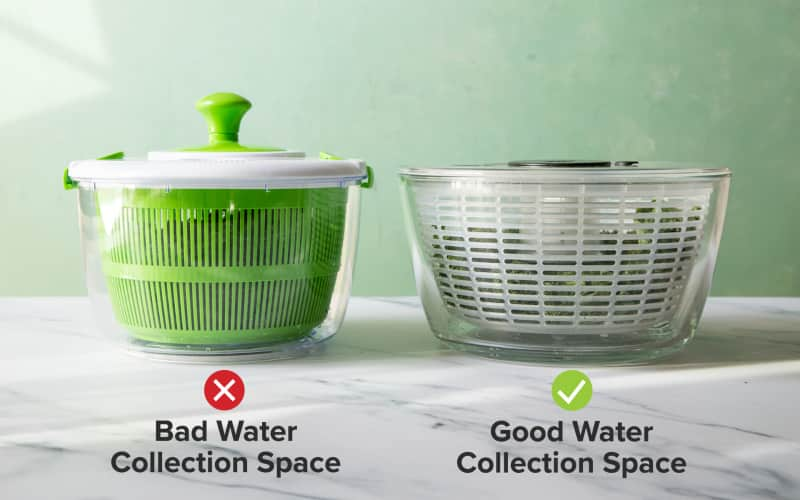
Nice to Have
- Quick Brakes: The best spinners had brakes that fully stopped the basket’s spinning within 1 second of being pressed. It was quick and easy to ensure that these models were entirely stationary before opening the lids, rather than having to wait an extra few seconds or potentially opening a lid while a basket was still spinning (and then needing to stop it by hand).
- Relatively Short Height: We preferred models that were 6 inches tall or shorter, since they were easier to store on a shelf or in a drawer.
What to Avoid
- Ineffective Drying: A few models left greens wet even after 30 seconds of spinning; we chalked this mediocrity up to ineffective or slow spinning mechanisms that couldn’t create enough force to fling water.
- Models with No Anti-Slip Bases: Spinners with bowls devoid of anti-slip grips slid and spun across our counters unless we held them steady with both hands.


We found that salad spinners with cranks (left) and pull cords (right) were hard to use.
- Pull Cords or Cranks: Models with pull cords and cranks required us to brace the spinners with two hands as well; we preferred the simple, singlehanded operation of plunger-style designs.
- Complicated or Ill-Fitting Designs: Some models had components that fit together loosely and jostled when the baskets started to spin. One spinner’s lid didn’t fit securely and was prone to dislodging in the middle of spinning. Other models had lids or other parts that could not be taken apart to dry but still trapped water that lingered even if we left them out to dry for days. And others had contoured, rib-like protrusions meant to help remove water that jutted into the basket and took up space unnecessarily.
- Small Water Collection Space: A few spinners didn’t have enough space under their baskets for water to collect. We found that models holding less than 1 cup of water inevitably got our greens wet again, defeating the entire drying process.
Minor Flaws
- Slow Brakes: A couple models’ brakes took about 3 seconds to fully stop the baskets’ spinning. This was not a major concern but still mildly annoying.
Other Considerations
- Plastic versus Glass or Metal Bowls: Manufacturers have released newly designed salad spinners with bowls made of glass or stainless steel. These models are marketed toward cooks who want to reduce their use of plastic tools. They’re also advertised as multitaskers: you can spin your greens dry, then remove the baskets and dress and serve your salads using the bowls. While we think these models are a small step in the right direction toward using less plastic, the lids, baskets, and spinning mechanisms are all still crafted from plastic. And none of the models we tested with metal or glass bowls worked as well as our longtime winner from OXO, which is made entirely of plastic. Our winner’s bowl has a small, tapered plastic spindle built into its bottom that serves as the axis for its spinning basket. The new models from OXO with metal and glass bowls are designed with removable plastic spindles aimed at recreating the winner’s mechanism. These removable spindles do not fit and hold as securely as our winner’s built-in spindle, so their baskets were slightly destabilized as they spun. This prevented the spinners from reaching high speeds and drying greens quite as thoroughly. The glass-bowled model was also quite heavy. If you’d still like to avoid as much plastic as possible, we’d recommend the stainless-steel version of our winner, which was easy to use but slightly less effective at drying greens.

The Tests
- Fill spinners with baby spinach, noting capacity and any features that limit available space
- Clean and spin maximum capacity of each spinner filled with blend of spring greens
- Use spinners to dry measured amounts of baby spinach and water
- Place empty basket inside bowl, adding water gradually until lower portion of basket is submerged, indicating that greens would become wet
- Clean and spin 3 large leeks (halved lengthwise and chopped), as in Rustic Potato-Leek Soup
- Spin 1 pint quartered cherry tomatoes, reserving extracted tomato juice, as in Greek Cherry Tomato Salad
- Clean and spin 1 large head curly kale
- Wash according to manufacturer instructions throughout testing
How We Rated
- Cleanup: We assessed how simple the salad spinners were to clean and whether they had any parts that trapped water.
- Ease of Use: We tested how easy it was to open, fill, close, and operate the spinners, and we noted any aspects of the models’ designs that made them difficult or awkward to operate.
- Performance: We evaluated how effectively and thoroughly the salad spinners dried greens and other produce.
